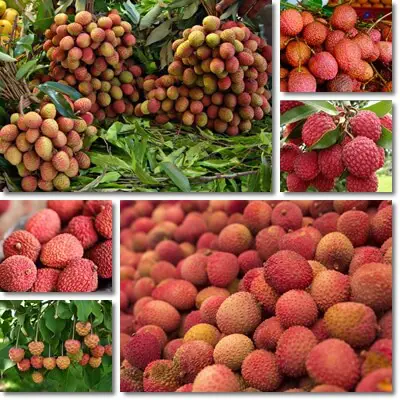The average glycemic index of lychee is 60, a moderate score. However, there is great variation, with some fruits being lower than 50 on the GI scale and others as high as 70 or higher. Given that it’s a moderate glycemic food, lychee does raise blood sugar. To what extent is a matter of how much of the fruit you eat at once. Ideally, if you have diabetes or pre-diabetes, it’s advisable to eat small servings, preferably not every day. Overall, lychee is good for diabetics only when consumed reasonably, according to each diabetic patient’s individual nutritional requirements and particularities of their condition.
Lychee glycemic index: moderate to high
The glycemic index (GI) is a scale that measures how fast the carbohydrates in a food raise blood sugar levels. Between 0-55 is a low GI. Between 56-69 is a moderate GI. Between 70-100 is a high GI. The lower the glycemic index score of a fruit , the lesser the effects on blood sugar. Conversely, the higher the score, the greater the effects. If are diabetic or pre-diabetic and looking to better manage your blood sugar, then it’s good to choose low GI foods over high GI ones, the lower the better.

The glycemic index of lychee is variable, typically ranging from moderate to high. The fresh fruit has an average GI score of around 60, which is moderate. What this means is lychee raises blood sugar levels, but when eaten in modest amounts, the rise is manageable. In some instances, the fruit has been found to have a glycemic index as high as 70 or higher.
At the same time, lychee can be low GI too with a score lower than 50). In one study, lychee GI was 47.9 ± 6.8 (in healthy subjects) and 60.0 ± 8.0 (in type 2 diabetics). Source
You might be interested to know:
Lychee glycemic load: low to moderate
The glycemic load (GL) is a scale that measures how fast the carbohydrates in a serving of a food raise blood sugar levels. Between 0-10 is a low GL. Between 11-19 is a moderate GL. Over 20 is a high GL. Typically, the smaller the serving of a food, the less carbohydrates you get from it and the lower its GL. The bigger the serving, the more carbs you get and the higher the GL. The glycemic load is determined based on the following formula: the glycemic index multiplied by the number of carbohydrates in a serving, divided by 100.
Given an average GI of 60 (for type 2 diabetics), a serving of 5 lychees without peel and seed has a glycemic load of 4.77, estimated at 5 (low GL). A serving of 10 litchis without peel and seed (estimated weight: 96 g) has a glycemic load of 9.54, estimated at 10 (low GL score, bordering on moderate).
A serving of 100 g has a GL score of 9.9, estimated at 10 (low score, bordering on moderate). A cup of the fresh fruit at 190 g has a GL score of 18.8, estimated at 19 (moderately high). Considering the GL score of a food is dependent on portion size, as a diabetic, the less you eat at once, the better it is for blood sugar control.

Lychee nutrition for diabetes
Peeled lychee fruits are a generous source of vitamin C and regular, but reasonable consumption may promote benefits for wound healing. This is thanks to vitamin C which holds antibacterial properties, has a strong anti-inflammatory action and supports the production of collagen for skin repair. 100 g of the peeled fruit contains 71.5 mg of vitamin C, whereas 1 cup at 190 g contains 135.8 g of the vitamin.
Next, lychee are a good source of several B vitamins: B2, B3, B5 and B9. B vitamins support nervous system activity and may hold some benefits for diabetes-associated nerve damage. Small amounts of minerals (calcium, copper, iron, magnesium, manganese, phosphorus, potassium, selenium, zinc) make the fruit a source of vitality and energy and promoter of overall good health. But the most relevant aspect of lychee nutrition, relevant for diabetes that is, is lychee carbohydrate content and profile.
See the complete article: Can You Eat Lychee With Diabetes?
How many carbs in lychee?
100 g of fresh, raw lychee has 16.53 g of carbs. One cup of the fruit at 190 g provides 31.4 g of carbs. One fruit without peel and seed (estimated weight per fruit: 9.6 g) provides 1.59 g of carbs. 10 lychees without peel and seeds (estimated weight: 96 g) provide 15.9 g of carbs. The peel and seed are best not eaten. While the peel is inedible, lychee seeds contain a toxin that can cause severe hypoglycemia and encephalopathy, especially the unripe fruit eaten in large amounts.
How much sugar in lychee?
100 g of the fresh, raw fruit contains 15.23 g of sugar. One cup at 190 g has 28.94 g, while one fruit without peel and seed (9.6 g a fruit) has 1.46 g. 10 lychees without peel and seeds (estimated weight: 96 g) provide 14.6 g of sugar. With lychees, almost the entire carbohydrate content is consists of sugars. Very little is dietary fiber to balance the carbohydrates which explains the higher glycemic index score compared to other fruits.
Does lychee raise blood sugar?
Yes, actually. Eating lychee does raise blood sugar levels, with or without diabetes. But depending on how much of the fruit you eat at once (portion size), the rise in blood sugar generated can vary extensively. Typically, the smaller the portion size, the less carbohydrates you get from it and the lesser the effects on blood sugar. The bigger the serving size, the more carbohydrates it contains and the more pregnant the effects. If you have diabetes type 2 or 1 or pre-diabetes and want to include lychees in your diet, then eating small amounts at once is a good strategy for avoiding blood sugar spikes.
